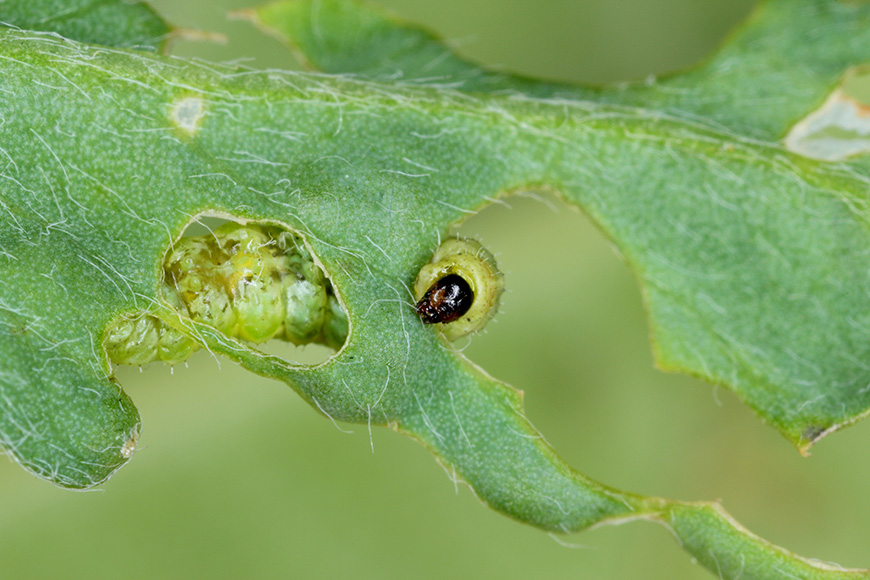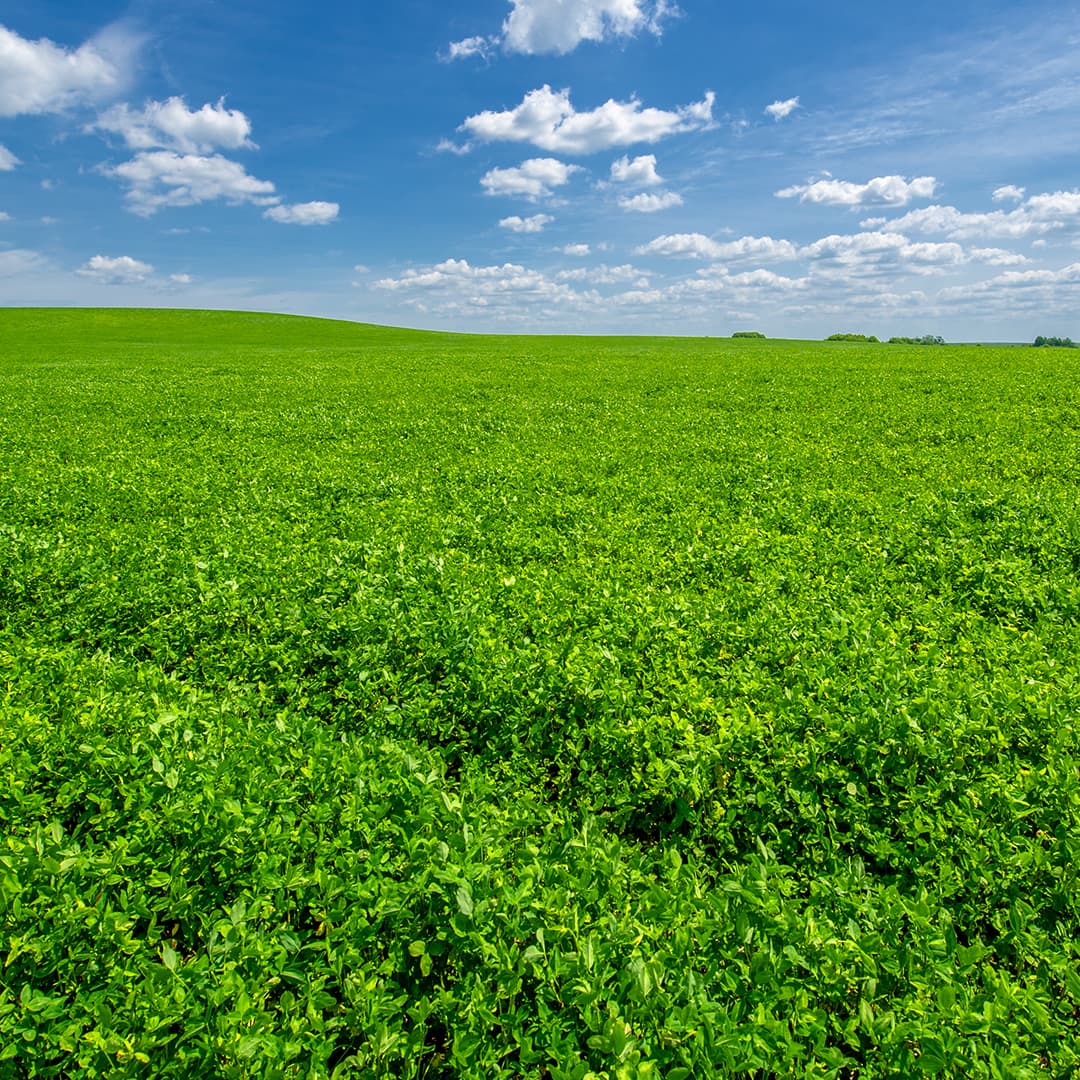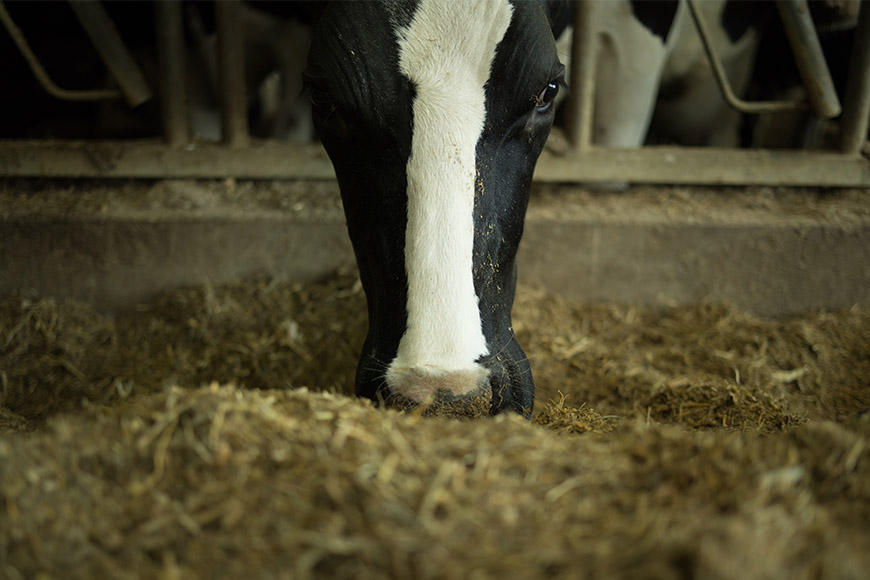The alfalfa weevil is one of the most significant and destructive pests in alfalfa. In some geographies, populations of the pest have been rising in recent years. Alfalfa weevils appear quickly in the spring and can cause devastating damage fast. As an alfalfa grower, it’s important to understand this insect and develop an action plan in case an infestation targets your fields.
Alfalfa weevil larvae are small, green worms. Each has a wide white stripe down the center of its back and a black head. The adult alfalfa weevil is a light brown snout beetle that has a darker brown stripe down its back.
“Growers should be looking for weevils right away in the spring, once alfalfa has initiated growth,” advised Kirk Whittig, Forage Genetics International account manager based in the Intermountain West and Pacific Northwest. “Larval feeding is easy to spot but sometimes small larvae hide in new growth leaflets at the top of the plant that haven’t fully unfolded.”
Early Spring
Early harvesting is also an effective tool. If alfalfa weevil populations are high, cutting early can dramatically reduce weevil densities because it removes their food and shelter source while exposing them to harmful sun rays. Reports indicate that harvesting can reduce pest populations by 95-98%.1
“It’s important to note that alfalfa weevils can continue to feed while hiding under the windrow after first cutting. If you don’t kill the weevils before harvest, you need to get the first cutting dried and baled as quickly as possible to keep the regrowth for second cutting from getting destroyed or damaged,” shared Whittig.
Scouting and following economic thresholds is a reliable way to determine whether chemical action is warranted. However, the decision comes down to the grower, their risk tolerance and goals.
“Growers pushing for high performance will often spray once a few weevils are found because the pest moves fast and creates damage quickly,” explained Whittig. “There are defined thresholds out there, but if you want high-quality hay, I recommend growers get after it as quickly as possible.”
Whittig recommends using Steward® EC insecticide, especially since it can be chemigated. For growers in the Intermountain West, Warrior II with Zeon Technology® is another strong choice for weevil control. Whittig also recommends adding an adjuvant like WETCIT® to your spray solution to help increase insecticide efficacy.
Alfalfa weevil can be a major threat to forage yields and quality, but with proactive management and an action plan in place, you’ll be well prepared to combat the pest. For more guidance or information on pest control in alfalfa, contact your local NEXGROW® dealer.
1 Alfalfa Weevil. University of Illinois Extension. Available at: http://extension.cropsciences.illinois.edu/fieldcrops/alfalfa/alfalfa_weevil/.
© 2023 Forage Genetics International, LLC. NEXGROW® is a registered trademark of Forage Genetics International, LLC. All other trademarks are property of their respective owners.
About The Weevil
Alfalfa weevils begin their destruction as soon as they hatch. In fact, they cause the most damage in their larval state, chewing large holes in foliage, leaving a skeletonized, shredded looking plant. Adult weevils feed on plants as well, but nowhere near the extent of larvae. Plus, the adults spend the hot summer months in a dormant state, away from alfalfa fields.Alfalfa weevil larvae are small, green worms. Each has a wide white stripe down the center of its back and a black head. The adult alfalfa weevil is a light brown snout beetle that has a darker brown stripe down its back.
Life Cycle
Since most of the damage comes from larvae, alfalfa weevils are the biggest threat early in the season, typically before first cutting.“Growers should be looking for weevils right away in the spring, once alfalfa has initiated growth,” advised Kirk Whittig, Forage Genetics International account manager based in the Intermountain West and Pacific Northwest. “Larval feeding is easy to spot but sometimes small larvae hide in new growth leaflets at the top of the plant that haven’t fully unfolded.”
Early Spring
- Female adults insert eggs inside alfalfa stems.
- Larvae hatch and begin feeding on the stem.
- Larvae emerge from the stem and move quickly to newest growth.
- Larvae feed on the foliage for 3-4 weeks.
- Larvae spin cocoons on plants and enter the pupal stage for 1-2 weeks.
- Adults emerge from cocoons and feed for 1-2 weeks.
- Adults leave alfalfa fields and move to sheltered areas for the hot summer months.
- Adults return to alfalfa fields upon cooler weather.
Management Strategies
Biological and cultural control practices can help keep alfalfa pests below economic levels. For example, alfalfa weevil has several natural enemies, including lady beetles and parasitoid wasps, that can help keep populations at bay.Early harvesting is also an effective tool. If alfalfa weevil populations are high, cutting early can dramatically reduce weevil densities because it removes their food and shelter source while exposing them to harmful sun rays. Reports indicate that harvesting can reduce pest populations by 95-98%.1
“It’s important to note that alfalfa weevils can continue to feed while hiding under the windrow after first cutting. If you don’t kill the weevils before harvest, you need to get the first cutting dried and baled as quickly as possible to keep the regrowth for second cutting from getting destroyed or damaged,” shared Whittig.
Scouting and following economic thresholds is a reliable way to determine whether chemical action is warranted. However, the decision comes down to the grower, their risk tolerance and goals.
“Growers pushing for high performance will often spray once a few weevils are found because the pest moves fast and creates damage quickly,” explained Whittig. “There are defined thresholds out there, but if you want high-quality hay, I recommend growers get after it as quickly as possible.”
Whittig recommends using Steward® EC insecticide, especially since it can be chemigated. For growers in the Intermountain West, Warrior II with Zeon Technology® is another strong choice for weevil control. Whittig also recommends adding an adjuvant like WETCIT® to your spray solution to help increase insecticide efficacy.
Alfalfa weevil can be a major threat to forage yields and quality, but with proactive management and an action plan in place, you’ll be well prepared to combat the pest. For more guidance or information on pest control in alfalfa, contact your local NEXGROW® dealer.
1 Alfalfa Weevil. University of Illinois Extension. Available at: http://extension.cropsciences.illinois.edu/fieldcrops/alfalfa/alfalfa_weevil/.
© 2023 Forage Genetics International, LLC. NEXGROW® is a registered trademark of Forage Genetics International, LLC. All other trademarks are property of their respective owners.



